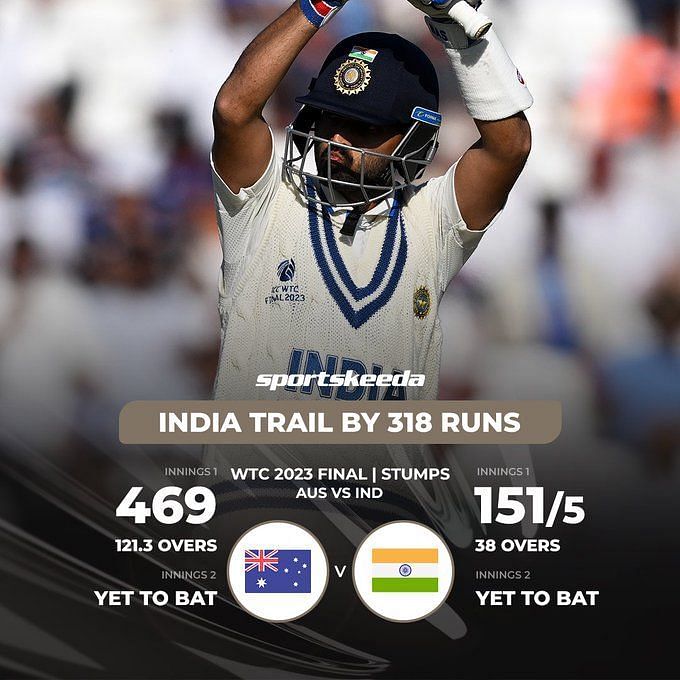
3 things Indian pacers can learn from Australia after 1st innings of the WTC final
Team India find themselves in a perilous situation as they seek to resurrect their hopes of winning the World Test Championship mace, with Australia well on top of the final after Day 2 at The Oval in London.
In pursuit of Australia's first-innings total of 469, the Indian batting lineup came a cropper and at 151/5 ahead of Day 3, require a miracle to storm back into the contest.
Yet, a good reason why they find themselves in this situation is the failure of their bowlers to step up and bundle Australia out after captain Rohit Sharma opted to field first.
On a surface with a nice grass cover and overcast skies at the time of the toss, the bowlers would have been expected to run through the Australian batting unit. Yet, they were all over the place and had to bear the wrath of Travis Head and Steve Smith's mastery.
Going by how the Aussies responded with the ball, there are quite a few lessons that their Indian counterparts can learn from them.
Here's an analysis of three such aspects below.
#1 Planning better according to the batter's strengths and weaknesses
When Mohammed Shami came around the wicket to David Warner in the first over of the WTC final, it seemed as though the Indian seamers had their plans in place with the left-handed opener known to be susceptible against that angle. As the contest progressed though, it turned out to be an aberration.
A good case in point is the manner in which Travis Head was allowed to get his eye in and not look back thereafter. He was offered too much width and for a strong backfoot player square of the wicket, the length just wasn't full enough to trouble him. He duly cashed in and by the time the seamers resorted to the short-pitched plan, he was already in the 90s.
Given that the short ball has troubled him in times gone by, the fast bowlers could have tried that against Head early on in the innings. Australia did their homework against Rohit Sharma though, keeping a long leg in place and dangling the carrot with the Indian skipper often perishing attempting the pull shot in recent times.
It nearly worked too as he mistimed a couple of his shots in that region. Clearly, India's fast bowlers can take a cue from how their Australian counterparts stuck to their plans before allowing the batters to get their eye in.
#2 Gauging the right length for the conditions
While Mohammed Siraj got the ball to swing by pitching it full enough in the first session of the opening day, Shami was guilty of bowling far too many back-of-a-length deliveries. This has been a feature of his bowling in England over the years and has resulted in a number of plays and misses as opposed to nicking the batter off.
Cut to the Australian bowling essay and Scott Boland, another bowler whose natural radar is to bowl back of a length, picked the cue much earlier. In just his second over, he managed to pitch it fuller on a good length and even got the ball to jag back in sharply as Shubman Gill misjudged a leave rather poorly.
This was the hallmark of Pat Cummins' opening spell too and once the Australian seamers got a hang of it, the Indian top order fell prey to it.
If only India's fast bowlers had done something similar under overcast conditions, things could have worn a completely different look in the WTC final.
#3 Perseverance in holding up an end

India might have scored at a positive clip in their batting essay, but the Australian pace attack never seemed bogged down by the same on Day 2 of the WTC final.
In fact, the hallmark of this pace unit over time has been their ability to relentlessly toil away and stick to their plans to give themselves the best chance of inducing the edge.
Umesh Yadav in particular was guilty of not doing the same in the first innings, as he dished out plenty of freebies to let Australia off the hook. With Shardul Thakur also going astray with his radar, control was a distant reality for the Indian attack despite looking to make the best of a green top and cloudy skies.
The situation of the game suggests that it might be too late to set things right in the second innings. Yet, India must believe and give themselves the best chance to do so. Sticking to a patient radar in and around the off stump and probing away as Australia did early on in their bowling innings is imperative to their cause.
Does India still stand a chance of making a comeback in the WTC final against Australia? Have your say in the comments section below!
Also read: 3 teams that would have benefited from having Travis Head in IPL 2023

